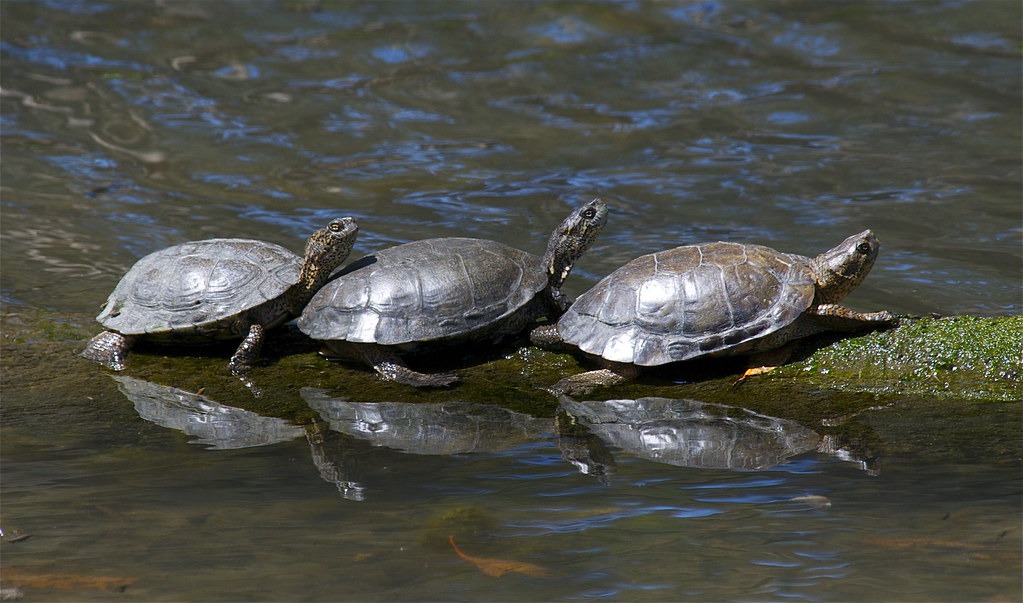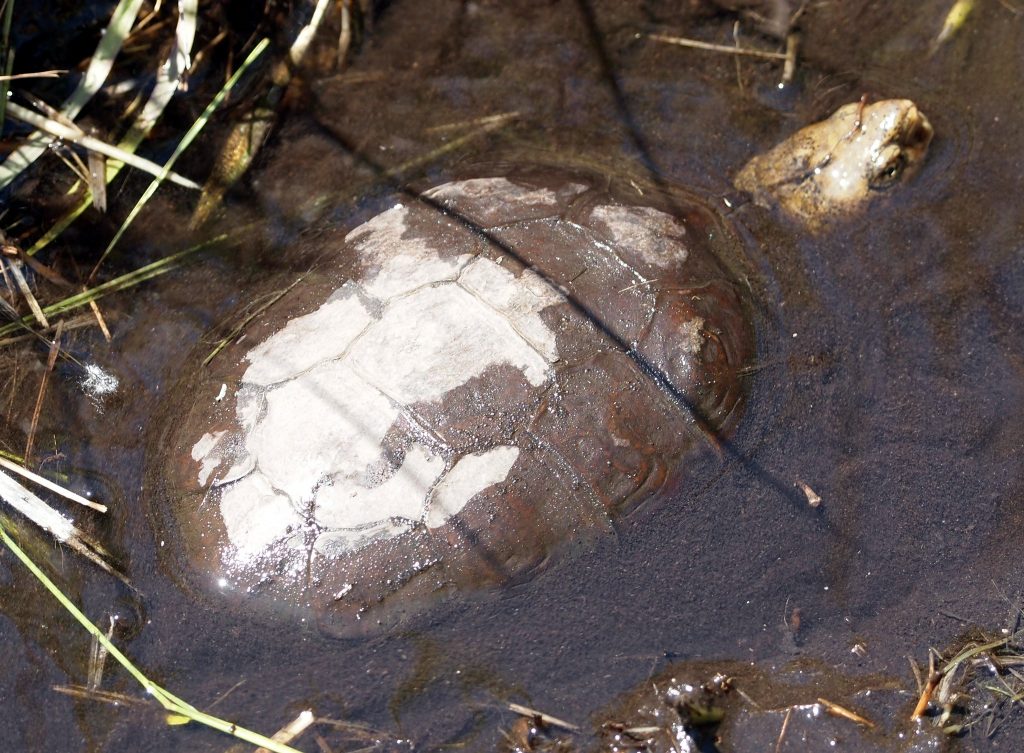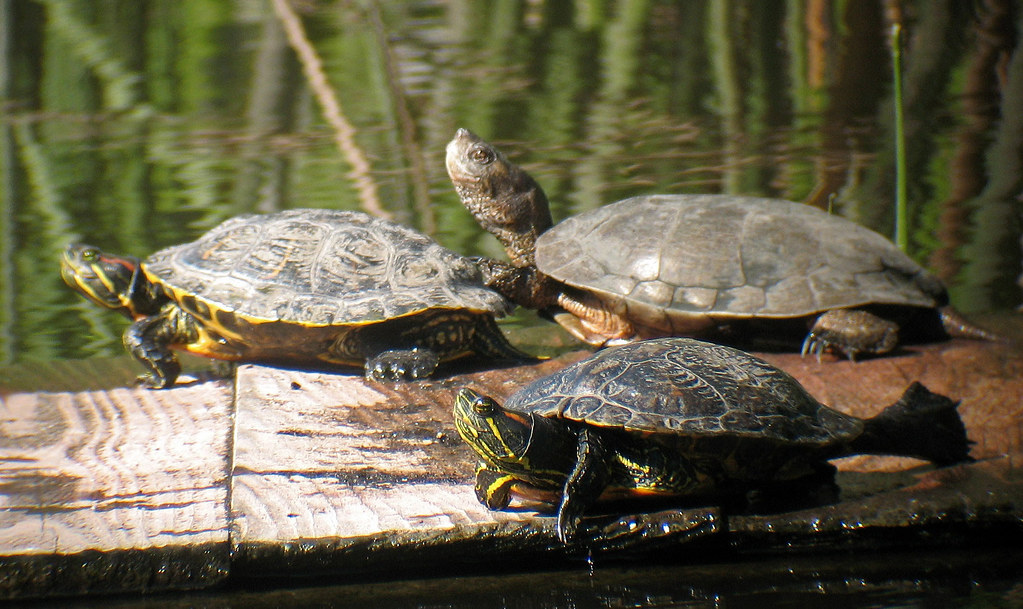Morro Bay Wildlife Spotlight Guest Post by Tess Badrigian
Tess is a Morro Bay native who has always loved the estuary and the wildlife that call it home. She studies biology and Geographic System Information at Cuesta College. After she receives her Associate Degree, Tess plans to pursue a Bachelor of Science in Environmental Management and Protection. Tess also enjoys writing, kayaking, and volunteering in the local community.
Western pond turtles: habitat and range
If you want to see a western pond turtle (Actinemys marmorata), you must be light on your feet. If they sense something strange, they will hide in defense. Populations of these hard-shelled animals are spread out along the west coast of North America, from parts of Washington state in the north all the way to Mexico in the south. Western pond turtles also reside in the Morro Bay watershed and are commonly found in Sweet Springs Nature Preserve in Los Osos. A small body of freshwater runs through the preserve and empties into the estuary. This body of water, particularly its slowest sections, provide habitat to western pond turtles.

Though we are lucky enough to have these elusive creatures on the Central Coast, they have not been seen in Canada for decades. They were listed as extirpated under Canada’s Species at Risk Act when it became law in 2002. They currently rank as vulnerable to the threat of extinction according to the International Union for Conservation of Nature (IUCN). And, in California, they are considered a species of special concern.
What western pond turtles look like and how to spot them
Most western pond turtles make their homes in streams, rivers, ponds, lakes, or marshes. To spot one, scan the water, rocks, and nearby logs for a shallow-domed oval shell, around eight inches in length, with dark brown to olive coloring.

These turtles are dimorphic, meaning that the males and females of the species are easy to tell apart. In the case of the western pond turtle, the males have pale yellow unmottled throats, while the females’ throats are mottled with darker color. This makes the two sexes easy to identify.
Life history of western pond turtles
Just like their shells, western pond turtles are durable. They can live to be 50 years old and can survive out of the water for 200 days. These long-lived turtles take ten to twelve years to reach reproductive age. Once they do, females build nests for their future hatchlings on land. Most western pond turtles build their nests about 160 feet from the edge of the water in areas of clay or silt that are not too wet. Females lay between five and thirteen eggs per clutch, either once or twice a year.
Adult western pond turtles are omnivorous. Hatchlings and juveniles eat zooplankton. Later, when they are around three years old, they begin to consume a wider variety of foods including insects, small fish, tadpoles, frogs, algae, detritus, and plants.
Predators and threats
Despite their strong shells, the western pond turtle must always be aware of predators. Raccoons, ospreys, other birds, and coyotes can sneak up on unsuspecting turtles to enjoy a crunchy meal.

Invasive species, like the red-eared sliders shown in the picture below, also pose a threat to western pond turtles by competing with them for habitat and food.

On April 10, 2015, the U.S. Fish and Wildlife Service announced that Endangered Species Act protections may be warranted for the western pond turtle. Threats like habitat destruction and encroachment make the future survival of the western pond turtle uncertain.
What you can do to help western pond turtles
To help prevent these turtles from becoming extinct locally, as they are now in Canada, you can participate in these easy day-to-day activities:
- Picking up trash: western pond turtles can become ensnared or entangled in fishing line, rope, and other trash items. They may also confuse litter for food and accidentally ingest the trash. When this happens, the turtle’s digestion tracts can become blocked and lead to starvation or death.
- Reduce your pesticide and fertilizer use. This will help prevent pollution from leaking into the streams and in which the western pond turtles live and hunt for food.
- Spread awareness of these fascinating creatures by sharing this blog with your friends and family.
Subscribe to our weekly blog to have posts like this delivered to your inbox each week.
Help us protect and restore the Morro Bay estuary!
- Donate to the Estuary Program today and support our work in the field, the lab, and beyond.
The Estuary Program is a 501(c)3 nonprofit. We depend on funding from grants and generous donors to continue our work. - Support us by purchasing estuary-themed gear from ESTERO. This locally owned and operated company donates 20% of proceeds from its Estuary clothing line and 100% of Estuary decal proceeds to the Estuary Program. Thank you, ESTERO!
- Purchase items from the the Estuary Program’s store on Zazzle. Zazzle prints and ships your items, and the Estuary Program receives 10% of the proceeds. Choose from mugs, hats, t-shirts, and even fanny packs (they’re back!) with our fun Estuary Octopus design, our classic Estuary Program logo, or our Mutts for the Bay logo.